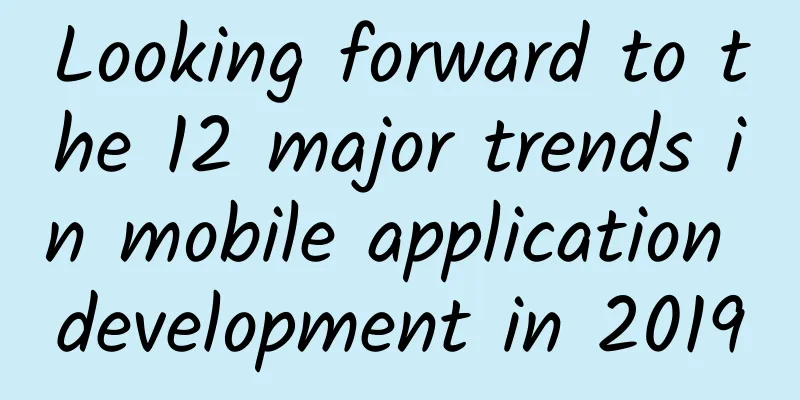Looking forward to the 12 major trends in mobile application development in 2019

|
【51CTO.com Quick Translation】In just a few years, the way we access the Internet has rapidly changed from "desktop + laptop" to "smartphone + mobile terminal". According to the global digital report of the We are Social website: in 2018, the number of global smartphone users has exceeded 5.135 billion (please see https://wearesocial.com/us/blog/2018/01/global-digital-report-2018 for details).
We are used to using various mobile applications frequently in our daily lives, and of course we are also consuming various products and services provided by them, including personalized experiences of virtual reality (VR) and augmented reality (AR). According to Statista (a market research and data release website), by 2020, mobile applications will generate $188.9 billion in revenue worldwide (please see https://www.statista.com/statistics/269025/worldwide-mobile-app-revenue-forecast/). According to Moore's Law, the integrated chips in smartphones will continue to improve in 2019. At the same time, as 5G networks are "blooming everywhere" in various countries, mobile application developers will have more room to play, and the efficiency and even complexity of mobile applications will develop by leaps and bounds. Now, let's boldly look forward to their various development trends and room for improvement in development and user experience. 1. Speed up mobile page loading with AMP and EMM Since 2016, many enterprises have continuously monitored and optimized various key business applications through Application Performance Management (AMP) and Enterprise Mobile Management (EMM) to improve service reliability and page quality. Through management, they guarantee the user's browsing experience and reduce the total cost of IT (TCO). By integrating AMP and EMM into the design framework of mobile applications, developers have been able to integrate HTML (and H5) pages to be more suitable for mobile terminals and have better display effects. Facebook Instant Articles is one of the many successful cases. It not only greatly shortens the time for web page loading and content downloading, but also adds interactive operation functions such as "tilt the device to view the full picture". In 2019, these monitoring tools and indicators will further help users solve page loading bottlenecks and improve the overall quality of mobile pages. 2. Machine Learning and Artificial Intelligence The scope and extent of the use of artificial intelligence (AI) and machine learning in mobile applications have far exceeded our imagination. One of the main forms of AI is chatbots. A typical example is Siri, which is a successful application of machine learning and artificial intelligence technology, and can interact with users in a friendly manner on smartphones. Nowadays, major well-known manufacturers have also launched their own smart speaker products, such as Apple's HomePod, Amazon's Echo (with Alexa behind it), Baidu's Xiaodu, and Tmall Genie. In 2019, as users’ demand for virtual assistants and chatbots increases, mobile applications related to machine learning and artificial intelligence will surely develop rapidly. 3. Rising demand for wearable devices and the Internet of Things With the hot sales of Apple Watch, people began to be keen on various wearable devices. Various application developers in the industry also quickly followed up with the research and development of mobile applications. Currently, many watch and fitness industries are targeting the business opportunities of smart watches. However, most companies are still superficial, and only cutting-edge companies such as Zomato (a food recommendation platform, the Indian version of Dianping.com) and Uber can really devote themselves to the research and development of mobile applications. In 2019, wearable devices will further complement the Internet of Things. Various wristbands, fitness bands, sports trackers, and their related mobile applications will become more intelligent and better able to meet the personalized needs of users. 4. Chatbots will get better According to Statista's forecast, the global chatbot market size will jump from US$1 billion in 2016 to US$1.25 billion in 2025. (Please see https://www.statista.com/statistics/656596/worldwide-chatbot-market/ for details) It can be seen that chatbots will be an indispensable part of digital reality services. Today, chatbots mainly play the role of virtual assistants for users in mobile applications. With the continuous advancement of artificial intelligence technology, we can now easily integrate chatbots into various mobile applications without the need for additional complex coding. An interesting chart from Digital Commerce shows that more than half of B2B buyers prefer self-service CRM (customer relationship management) services (see https://www.digitalcommerce360.com/2018/10/02/infographic-b2b-buyers-want-self-serve-customer-service/). Chatbots are a new way to expand customer relationship management. 5. Augmented reality and virtual reality impact mobile strategy The popularity of "Pokemon Go" has passed like a monsoon, but the effects and experiences of AR and VR have long been deeply rooted in people's hearts. We predict that the revenue of this field will exceed 2 trillion US dollars by 2020. Both developers and user players hope that cool AR and VR software/hardware can be put on the market and achieve the effect of subverting various current business models. Therefore, they will continue to increase their investment in research and development in this field. 6. Mobile Wallet/Payment Gateway Contactless wireless payment is a basic requirement for many consumers to use various mobile applications. We have experienced the payment era from using cash in the past, to "swiping" various credit and debit cards, and now mobile wallets and digital currencies. Moreover, this convenient and efficient payment method is subtly changing users' shopping methods and habits. In addition, the settlement method of mobile wallets can not only bring satisfactory user experience to enterprises and consumers, but also provide more secure encryption protection by integrating payment gateways such as Amazon Pay, Google Wallet, and PayPal. According to relevant regulatory provisions, we predict that in 2019, this type of payment method will continue to be strengthened and developed in the development of mobile applications. 7. More companies will invest in cloud integration In recent years, cloud computing and cloud integration have become an important part of IT system construction and development for various enterprises and organizations. By increasing the development of mobile applications related to cloud services, enterprises can achieve streamlined operations, reduced hosting costs, better storage and installation capabilities, while also enhancing user experience and retention. 8. Instant application, use on demand Instant apps, or free apps, are a type of native mobile app that appeared in 2016. As the name suggests, compared to regular apps, they are smaller, more user-friendly, more convenient, and more suitable for users to use them anytime and on demand because they do not require downloading and installation. As users' demands for better user experience and shorter loading time continue to increase, instant apps will receive greater improvements and optimizations in terms of reducing installation and shortening the switching waiting time for loading. 9. Pay more attention to mobile app security From Uber paying hackers a hush money after leaking user privacy to Facebook and Google admitting their security vulnerabilities, the cybersecurity community has never lacked headlines from major companies. Therefore, although mobile security is nothing new, app developers still need to invest more in cybersecurity to meet user data privacy and related legal requirements. It can be seen that the attention to and attack and defense of mobile application security vulnerabilities is actually a race and competition between white hats and black hats in the "dark forest". In 2019, this competition will continue and intensify. 10. Beacon Technology Beacon technology has been around for a while. Devices equipped with Bluetooth Low Energy (BLE) communication functions can send their IDs to the surroundings and allow applications that receive the IDs to send various messages. For example, stores equipped with this communication module can send discount coupons and store points to iPhone and iPad customers. In addition, airports can also use beacon technology to push useful information such as flights, parking, security checks, and retail after guiding passengers to download the corresponding applications. In 2019, we will see more airport beacon applications, mobile payment beacons, and even automated personal beacon applications. The overall trend in this field will be: through in-depth research and development, applications such as virtual tour guides and smoother personalized information sharing will be produced. 11. Influencing mobile UI/UX through predictive analytics Nowadays, mobile applications have evolved from simple functional implementation to assisting and improving everyone's daily workflow through friendly user interfaces and interfaces. High-tech companies such as Facebook, Google, and Apple have been able to continuously improve and enhance the UI/UX level of their applications by using AI predictive analysis. In 2019, more companies are bound to join in and benefit from it. 12. On-Demand Apps are becoming more popular As all industries are upgrading to an "on-demand use" model, their related applications no longer "occupy" the storage space of users' mobile devices for a long time, but provide users with online services such as UI/UX enhancements, mobile business facilities, predictive analysis, and business robots through cloud calls and external connections on demand. In 2019, with the advantages of the cloud, developers will further "study" the functions and efficiency of on-demand applications. Original title: 12 Mobile App Development Trends to Watch Out for in 2019, author: Amit Manchanda [Translated by 51CTO. Please indicate the original translator and source as 51CTO.com when reprinting on partner sites] |
<<: Android SDK Development - Release and Use Pitfalls
Recommend
[Pearl Science] A Scientific Look at Nano Pearl Powder
Nanomaterials refer to materials that have at lea...
The global server market cooled in 2019, but new infrastructure boosted the market
Recently, IDC, a world-renowned research organiza...
Why was the tiger talisman used to mobilize millions of troops in ancient times in the shape of a tiger? Why can it only be stolen and not forged?
On the eve of the Chinese New Year of the Tiger, ...
How big is the risk of COVID-19 spreading from animals to humans? How to prevent it? Experts explain →
From January 9, when Tianjin announced the first ...
A cosmic version of "The Wandering Earth"? Telescopes reveal the truth about the "wanderers" in outer space
Produced by: Science Popularization China Author:...
From January to August, the domestic market shipped 227 million mobile phones, of which 5G mobile phones accounted for 74.1%
[[425151]] 1. Overall situation of domestic mobil...
Tree rings are the most commonly remembered traces of time
Humans are the longest-lived mammals, but we stil...
The Ministry of Industry and Information Technology issued a notice on 43 apps that did not make thorough rectifications: WeChat, Tencent Video, iQiyi, Ctrip, etc.
On August 18, the Ministry of Industry and Inform...
How much does it cost to join a pet mini program in Qujing?
How much does it cost to join a pet mini program ...
Is the investment cost of Cangzhou Perfume Mini Program high? Cangzhou perfume mini program investment fee
What is the investment cost of Cangzhou Perfume M...
Someone farted during surgery and caused a fire? What else do you not know about the operating room?
Regarding the question of how patients wear cloth...
Talking about Android security 2 - Activity hijacking prevention program
The previous article introduced phishing vulnerab...
Can CATL's sodium battery, which impressed everyone as soon as it debuted, lead the domestic automobile industry into a new era?
Battery technology has always severely restricted...
How does Nayuki Tea develop its private domain?
Recently, "Nayuki drastically reduces prices...
Create an APP in four months from zero foundation
[[132507]] OK, actually, my title is a bit mislea...









